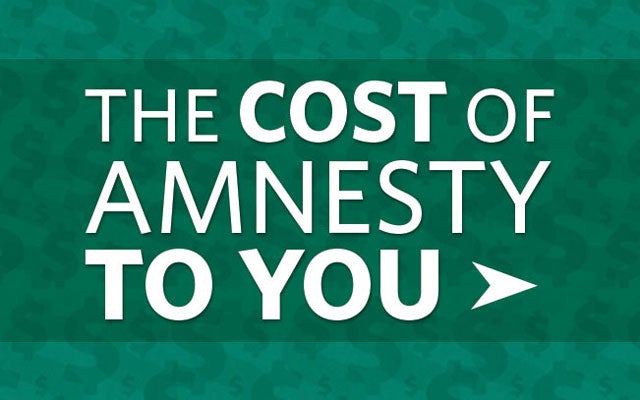Some proponents of comprehensive immigration reform (including amnesty) are trying to find support for their position in Heritage Foundation papers from long ago.
In the first paper they point to, from March 2006, Heritage rejected amnesty but also considered the economic effects of immigration. Since that time, there are two major differences to consider.
First and most importantly, at that time, Heritage had not yet done its own analysis of fiscal costs. But Heritage did just that in 2007, and today we released an updated study. The new study by Heritage fills the gap on the cost and estimates that the cost for amnesty and unlawful immigration is $6.3 trillion. Amnesty and a rush to an immigration bill that increases costs on taxpayers would be folly.
Since 2006, the welfare state and federal government spending have exploded, which makes amnesty an even more expensive proposition than it would have been in 2006 or 2007.
Unlawful immigrants’ future earnings will be limited, and they are more likely to be unemployed and utilize many welfare programs. With little earnings, these unlawful immigrants will not pay nearly enough taxes to make up for the government services they use and benefits from programs ranging from Obamacare to Medicare and even Social Security.
Therefore, taxpayers who are here legally will have to pay more in taxes to pay these new benefits.
Second, in the years since 2006 we have seen how Congress has considered gigantic “comprehensive” bills like Obamacare, the stimulus, Dodd-Frank, and cap and trade, among others. Congress has shown that taxpayers need to move to protect their wallets when politicians write long pieces of comprehensive legislation, and the people must prepare for poor results if it passes. Congress should instead tackle problems where there is more agreement first, then move on to more difficult problems.
The second paper some are pointing to is an even older Heritage paper from 1984 written by Julian Simon. That paper looked at 1976 data when it proclaimed, “it is frequently alleged that immigrants no sooner arrive in the U.S. than they become public charges, draining welfare money from the U.S. taxpayers and paying no taxes. Solid evidence gives the lie to this charge.”
Immigration was very different 40 years ago. It was less than a generation after major reforms of our system that started to emphasize family reunification and led to a dramatic change in the composition of our immigrant population. Indeed, Simon, in looking at the 1976 data, noted that “[e]ven more surprising is that immigrants on average have as much education as do natives.” While that may have been the case in 1976, now more than half of all unlawful immigrants lack a high school degree, and another 27 percent have only a high school degree. All immigrants in 1976 looked very different than unlawful immigrants now. Today’s research draws different conclusions because the data, facts and circumstances, and populations (all immigrants versus unlawful immigrants) are different.
Some want to assume the fiscal costs of amnesty can be swamped by economic growth. But the central economic test for immigration reform is whether it makes those who are legally in the country better off, not whether immigration or immigration reform increases the size of the economy.
Of course, net immigration increases output and national income. But whose after-tax income is then increased? If not those in the country legally, then amnesty fails the test. As George Borjas of Harvard University, considered among the nation’s leading experts on immigration, has noted, “almost all of this increase in GDP [is] accruing to the immigrants themselves as a payment for their labor services,” and not to current American taxpayers, who will bear the costs of amnesty.
The Heritage Foundation looks at the most recent data and conducts analysis with transparent methodology. Robert Rector and Jason Richwine certainly did that in the study released today, which comes to nearly 100 pages. We look at the most recent research to educate policymakers. Looking at data from 1976 or a study from 2006 that was superseded by work the next year will lead to erroneous conclusions about our recommendations.
Read the new report: The Fiscal Cost of Unlawful Immigrants and Amnesty to the U.S. Taxpayer
